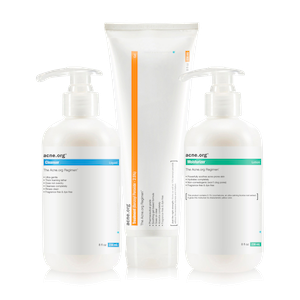Mercola article on autophagy - which is how your body recycles old tissues, and inhibiting mTor.
http://fitness.mercola.com/sites/fitness/archive/2016/03/11/autophagy.aspx
Visit the thread below on the mTor role in Acne where I would have posted if it hadn't been archived:
Potential role of FoxO1 and mTORC1 in the pathogenesis of Westerndiet-inducedacne.
Acne in adolescents of developed countries is an epidemic skin disease and has currently been linked to the Western diet (WD). It is the intention of this viewpoint to discuss the possible impact of WD-mediated nutrient signalling in the pathogenesis of acne. High glycaemic load and dairy protein consumption both increase insulin/insulin-like growth factor-1 (IGF-1) signalling (IIS) that is superimposed on elevated IGF-1 signalling of puberty. The cell's nutritional status is primarily sensed by the forkhead box transcription factor O1 (FoxO1) and the serine/threonine kinase mammalian target of rapamycin complex 1 (mTORC1). Increased IIS extrudes FoxO1 into the cytoplasm, whereas nuclear FoxO1 suppresses hepatic IGF-1 synthesis and thus impairs somatic growth. FoxO1 attenuates androgen signalling, interacts with regulatory proteins important for sebaceous lipogenesis, regulates the activity of innate and adaptive immunity, antagonizes oxidative stress and most importantly functions as a rheostat of mTORC1, the master regulator of cell growth, proliferation and metabolic homoeostasis. Thus, FoxO1 links nutrient availability to mTORC1-driven processes: increased protein and lipid synthesis, cell proliferation, cell differentiation including hyperproliferation of acroinfundibular keratinocytes, sebaceous gland hyperplasia, increased sebaceous lipogenesis, insulin resistance and increased body mass index. Enhanced androgen, TNF- and IGF-1 signalling due to genetic polymorphisms promoting the risk of acne all converge in mTORC1 activation, which is further enhanced by nutrient signalling of WD. Deeper insights into the molecular interplay of FoxO1/mTORC1-mediated nutrient signalling are thus of critical importance to understand the impact of WD on the promotion of epidemic acne and more serious mTORC1-driven diseases of civilization.
2013 John Wiley & Sons A/S.
Dietary intervention in acne: Attenuation of increased mTORC1 signaling promoted by Westerndiet.
The purpose of this paper is to highlight the endocrine signaling of Western diet, a fundamental environmental factor involved in the pathogenesis of epidemic acne. Western nutrition is characterized by high calorie uptake, high glycemic load, high fat and meat intake, as well as increased consumption of insulin- and IGF-1-level elevating dairy proteins. Metabolic signals of Western diet are sensed by the nutrient-sensitive kinase, mammalian target of rapamycin complex 1 (mTORC1), which integrates signals of cellular energy, growth factors (insulin, IGF-1) and protein-derived signals, predominantly leucine, provided in high amounts by milk proteins and meat. mTORC1 activates SREBP, the master transcription factor of lipogenesis. Leucine stimulates mTORC1-SREBP signaling and leucine is directly converted by sebocytes into fatty acids and sterols for sebaceous lipid synthesis. Over-activated mTORC1 increases androgen hormone secretion and most likely amplifies androgen-driven mTORC1 signaling of sebaceous follicles. Testosterone directly activates mTORC1. Future research should investigate the effects of isotretinoin on sebocyte mTORC1 activity. It is conceivable that isotretinoin may downregulate mTORC1 in sebocytes by upregulation of nuclear levels of FoxO1. The role of Western diet in acne can only be fully appreciated when all stimulatory inputs for maximal mTORC1 activation, i.e., glucose, insulin, IGF-1 and leucine, are adequately considered. Epidemic acne has to be recognized as an mTORC1-driven disease of civilization like obesity, type 2 diabetes, cancer and neurodegenerative diseases. These new insights into Western diet-mediated mTORC1-hyperactivity provide a rational basis for dietary intervention in acne by attenuating mTORC1 signaling by reducing (1) total energy intake, (2) hyperglycemic carbohydrates, (3) insulinotropic dairy proteins and (4) leucine-rich meat and dairy proteins. The necessary dietary changes are opposed to the evolution of industrialized food and fast food distribution of Westernized countries. An attenuation of mTORC1 signaling is only possible by increasing the consumption of vegetables and fruit, the major components of vegan or Paleolithic diets. The dermatologist bears a tremendous responsibility for his young acne patients who should be advised to modify their dietary habits in order to reduce activating stimuli of mTORC1, not only to improve acne but to prevent the harmful and expensive march to other mTORC1-related chronic diseases later in life.
FoxO, IGF-1, Western diet, acne, androgen, insulin, leucine, mTORC1, nutrition, prevention
Turning acne on/off via mTORC1.
Over the past 10 years, the increase in comprehension of the mechanisms behind acne has been truly exponential. Starting with the ethnological work of Cordain, accelerated by the epidemiological work of Adebamowo, supported by the clinical trials of Smith and Mann, Kwon, DiLandro and others, the interface of diet and acne is coming into focus. Melnik now presents an exceptional pair of papers that illustrate for dermatologists what translational research is all about. The Western diet, the role of dairy, FoxO1 and mTORC1, the interplay of agonists and antagonists, therapeutics present and future - the jigsaw puzzle is coming together.
2013 John Wiley & Sons A/S. Published by John Wiley & Sons Ltd.
Full article: http://www.ncbi.nlm.nih.gov/pmc/articles/PMC3746129/
http://www.landesbio..._full_text=true
http://www.lipidworl.../content/8/1/25
These papers on mTor & acne areexcellent summaries of all the known factors involved in acne formation and most of the research into cause and intervention from big pharma like isotretinoin, BP and metformin to EGCG and resveraterol. And of course diet, especially the western diet.
And I wish to point out that they citeover one hundred scientific studies into these factors and how nutrients and diet habits affect those factors and thus acne. And yet people keep claiming there's no scientific evidence that diet affects acne. I guess it's like climate change deniers. No amount of evidence will change their minds.
Mercola is well known quack. While HGL and the SAD contribute to acne and other health problems they are not the cause. Obesity, diabetes and acne are so much more complex than what we currently know despite these conditions being associated to a degree with modern habits.
 Acne.org Products
Acne.org Products